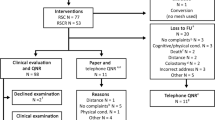Abstract
This study surveyed attitudes and practice patterns of urogynecologists regarding the use of synthetic mesh in pelvic reconstructive surgery. A web-based survey was administered to members of the American Urogynecologic Society. The survey evaluated the use of the mesh for sacrocolpopexy, suburethral sling, and vaginal pelvic reconstructive surgery. The survey had a 30.5% response rate. One hundred one (39%) respondents were women, and 158 (61%) were men. One hundred forty-seven (56.8%) participated in fellowship training. Two hundred forty-seven (99.5%) currently perform procedures using synthetic mesh, including 93% who perform sacrocolpopexy and 93% who perform suburethral slings. In a logistic regression model including gender, fellowship training, and practice setting, male surgeons and those who had not undergone fellowship training were more likely to use the mesh than those who were fellowship trained. Respondents use the mesh most commonly when performing sacrocolpopexies and suburethral slings. The use of the mesh for anterior and posterior colporrhaphy is less common.

Similar content being viewed by others
References
Cosson M, Debodinance P, Boukerrou M, Chauvet MP, Lobry P, Crepin G, Ego A (2003) Mechanical properties of synthetic implants used in the repair of prolapse and urinary incontinence in women: which is the ideal material? Int Urogynecol J Pelvic Floor Dysfunct 14:169–178; discussion 178
Ulmsten U, Henriksson L, Johnson P, Varhos G (1996) An ambulatory surgical procedure under local anesthesia for treatment of female urinary incontinence. Int Urogynecol J Pelvic Floor Dysfunct 7:81–85; discussion 85–6
Huebner M, Hsu Y, Fenner DE (2006) The use of graft materials in vaginal pelvic floor surgery. Int J Gynaecol Obstet 92:279–288
Brubaker L (2006) Editorial: Partner dyspareunia (hispareunia). Int Urogynecol J Pelvic Floor Dysfunct 17:311
Amrute KV, Eisenberg ER, Rastinehad AR, Kushner L, Badlani GH (2007) Analysis of outcomes of single polypropylene mesh in total pelvic floor reconstruction. Neurourol Urodyn 26(1):53–58
Fatton B, Amblard J, Debodinance P, Cosson M, Jacquetin B (2006) Transvaginal repair of genital prolapse: preliminary results of a new tension-free vaginal mesh (ProliftTM technique)—a case series multicentric study. Int Urogynecol J Pelvic Floor Dysfunct DOI 10.1007/s00192-006-0234-3
Williams TJ, Telinde RW (1962) The sling operation for urinary incontinence using mersilene ribbon. Obstet Gynecol 19:241–245
Lane FE (1972) Repair of post hysterectomy vaginal vault prolapse. Obstet Gynecol 20:72–77
Julian TM (1996) The efficacy of Marlex mesh in the repair of severe, recurrent vaginal prolapse of the anterior midvaginal wall. Am J Obstet Gynecol 175:1472–1475
Wu JM, Hundley AF, Visco AG (2005) Elective primary cesarean delivery: attitudes of urogynecology and maternal–fetal medicine specialists. Obstet Gynecol 105:301–306
Pauls RN, Kleeman SD, Segal JL, Silva WA, Goldenhar LM, Karram MM (2005) Practice patterns of physician members of the American Urogynecologic Society regarding female sexual dysfunction: results of a national survey. Int Urogynecol J Pelvic Floor Dysfunct 16:460–467
Author information
Authors and Affiliations
Corresponding author
Rights and permissions
About this article
Cite this article
Pulliam, S.J., Ferzandi, T.R., Hota, L.S. et al. Use of synthetic mesh in pelvic reconstructive surgery: a survey of attitudes and practice patterns of urogynecologists. Int Urogynecol J 18, 1405–1408 (2007). https://doi.org/10.1007/s00192-007-0360-6
Received:
Accepted:
Published:
Issue Date:
DOI: https://doi.org/10.1007/s00192-007-0360-6



